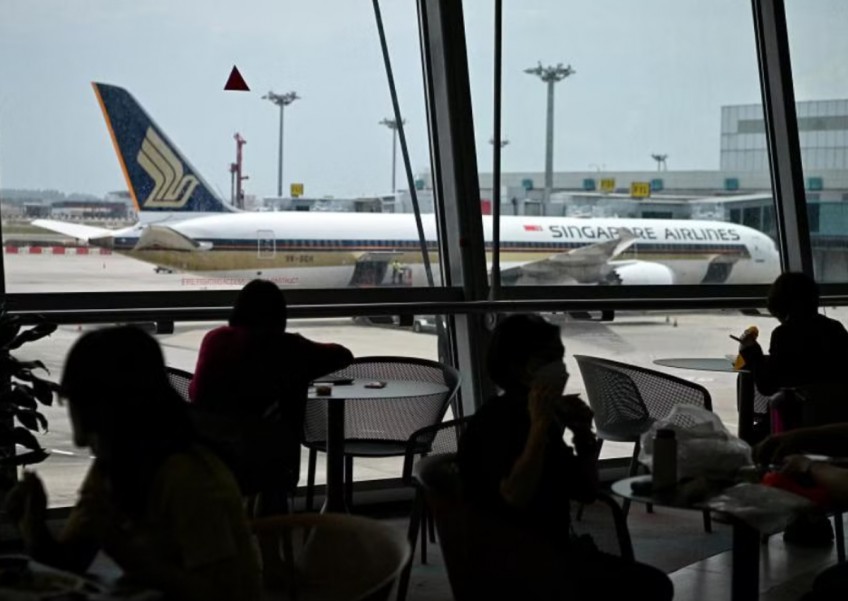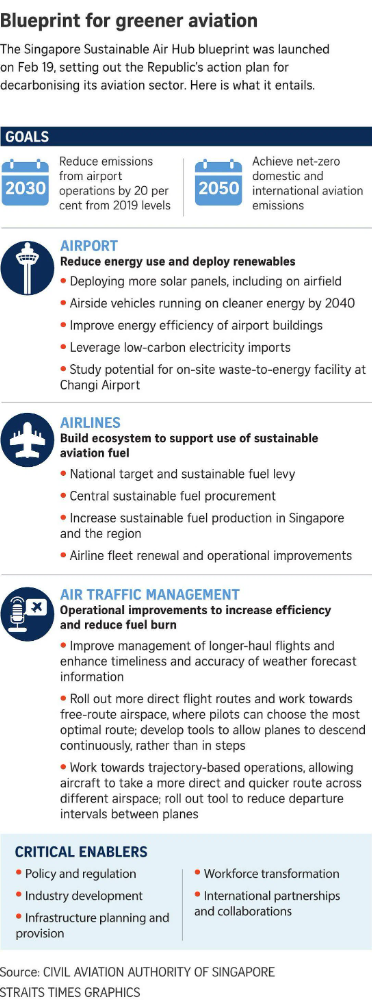Travellers to pay more for flights leaving Singapore from 2026 in push towards greener jet fuel


AsiaOne has launched EarthOne, a new section dedicated to environmental issues — because we love the planet and we believe science. Find articles like this there.
SINGAPORE — From 2026, travellers flying out of Singapore will pay higher air fares due to a levy that the Government will impose as part of a move to require flights departing from the city-state to use environmentally sustainable jet fuel.
The money collected from the passenger levy will go towards the bulk purchase of sustainable aviation fuel that airlines here will need to use, to kick-start adoption.
The eco-friendly fuel, which is mostly made from waste materials such as used cooking oil, is three to five times more expensive than conventional fuel. But it has been earmarked as a critical way for the aviation sector to decarbonise.
While the specific details are yet to be finalised, preliminary estimates from the Civil Aviation Authority of Singapore (CAAS) suggest that economy class passengers may incur an additional $3 levy for short-haul flights to Bangkok, $6 for medium-haul flights to Tokyo, and $16 for long-haul flights to London.
The estimates are based on a national target that Singapore has set for sustainable aviation fuel to constitute one per cent of all jet fuel used at Changi Airport and Seletar Airport in 2026. The eventual goal is to reach three per cent to five per cent sustainable fuel use by 2030.
The initiative is part of a sustainable air hub blueprint launched on Feb 19 by Transport Minister Chee Hong Tat at the second Changi Aviation Summit, which was held at Marina Bay Sands Expo and Convention Centre.
The blueprint outlines 12 initiatives for Singapore to tackle aviation emissions, with the medium-term objective of reducing carbon emissions from airport operations to 326 kilotonnes per year in 2030 — 20 per cent lower than 2019 levels.
By 2050, Singapore aims to reach net-zero domestic emissions from its airports, and net-zero international emissions from its carriers. This goal excludes future developments in Changi East, including Terminal 5. Emissions targets for these projects will be determined separately.
According to CAAS, Singapore is the first country in the world to introduce a levy to meet its sustainable aviation fuel goals. Other nations have implemented sustainable aviation fuel requirements as well, but in the form of mandates that are based on fixed volumes.
France and Sweden already require a minimum of one per cent sustainable jet fuel use and the European Union has agreed to rules mandating six per cent in 2030, rising gradually to 70 per cent in 2050.
Japan is planning a 10 per cent sustainable fuel mandate by 2030, while India is considering one per cent by 2027 for international flights, rising to five per cent by 2030.
The downside to such mandates, however, is that the market for sustainable fuel is still nascent and supply is uncertain, CAAS said.
In 2024, sustainable aviation fuel production is expected to triple to 1.875 billion litres, but this will account for just 0.53 per cent of global aviation's fuel needs.
Due to limited supply and high demand, the price of sustainable jet fuel is significantly higher and more volatile than conventional fuel, CAAS noted.
Some airlines have already begun to pass this added cost on to passengers. For example, Air France and KLM have an extra charge of between €1 and €24 (S$1.50 and S$35) on tickets to defray their green fuel cost.
CAAS said it decided to impose a levy instead of a mandate as this fixes the cost of using greener jet fuel here, giving certainty to travellers and airlines. CAAS will also manage costs by procuring sustainable fuel centrally on behalf of airlines, reaping economies of scale.
It said the sustainable fuel levy amount will be determined based on the prevailing national usage target and projected fuel price at the time. The levy will be subject to periodic review.
CAAS added the levy amount will not change if the actual price of sustainable jet fuel is different from what was projected. Instead, the volume of fuel purchased will be adjusted.
Chee said: "Whether we are able to meet, or exceed, our SAF (sustainable aviation fuel) target will be based on how much SAF can be purchased with the SAF levy at the prevailing SAF price."
He added: "If the supply increases and prices come down, which I hope so, we could go beyond our set target.
"Conversely, if sustainable aviation fuel prices shoot up and exceed projected levels, we would purchase less than our set target. But in both scenarios, the cost impact on travellers will be the same because the SAF levy remains unchanged."
CAAS said passengers will pay varying amounts of levies based on factors such as flight distance and class of travel, with business class and first class passengers paying more.
It could not provide more specifics when asked, citing the need for further industry consultation. More details will be announced in 2025, closer to implementation.
Chee said the cost impact of Singapore's one per cent sustainable aviation fuel target was assessed to be manageable, and sufficient lead time will be given to the industry and travellers before the levy takes effect in 2026.
At the same time, the one per cent target will provide an important demand signal to fuel producers and give them the incentive to invest in new production facilities, he added.
To ensure adequate supply of greener fuel, CAAS said the Government will also work with industry partners to boost sustainable aviation fuel production in Singapore and the region.
CAAS estimates that the use of sustainable jet fuel will reduce Singapore's international aviation emissions by about four per cent from 2030 business-as-usual levels.
Other initiatives to reduce aviation emissions here include deploying more solar panels at Changi and Seletar airports, and improving air traffic management over the next five years to reduce fuel burn.
Additionally, a renewable diesel trial at Changi Airport is scheduled for 2024, focusing on heavy specialised airside vehicles without electric models.
Plans to grow the electric vehicle fleet at the airport and increase the number of charging stations from 100 to 300 are also under way.
The CAAS blueprint also identified key enablers such as workplace transformation and international collaboration. In line with this, the authority will set up an Asia-Pacific sustainable aviation centre to develop region-specific research capabilities.
The sustainable air hub blueprint, which builds on proposals mooted in 2022 by an international panel, was due to be published in 2023 but got pushed back.
This was so CAAS could consider developments from an International Civil Aviation Organisation conference in Dubai in November 2023, when the 193 member states agreed to reduce aviation emissions by five per cent by 2030 through the use of cleaner fuels.
On Feb 19, Chee emphasised the need for a balanced approach to sustainability.
"It will hurt our air hub and our economy, and raise the cost of travel for passengers, if we are overly ambitious with our sustainability goals," he said.
Chee said Singapore will monitor global developments and the wider availability and adoption of sustainable jet fuel in the next few years, before deciding on its targets beyond 2026.
He added: "The future of aviation must continue to be a story of growth, balanced with sustainability. Good for people, good for businesses, good for the environment."

[embed]https://www.youtube.com/watch?v=Wc-rt80hROQ&t=1s[/embed]
ALSO READ: Singapore bags $750m in aerospace investment projects, sector to hire 2,500 more workers: EDB
This article was first published in The Straits Times. Permission required for reproduction.